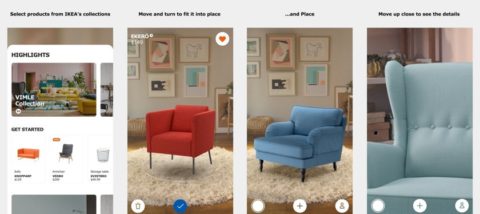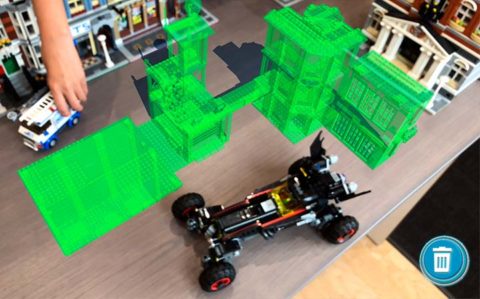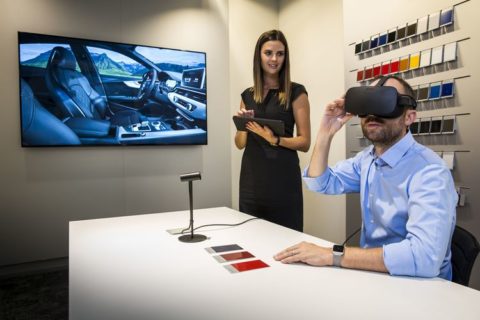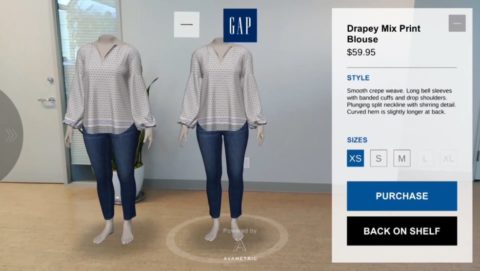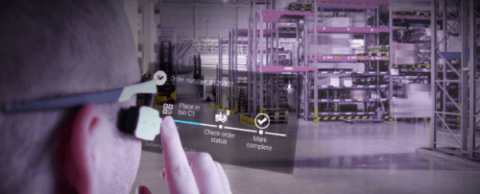Table of Contents
You have probably heard lots of news lately about big brands exploiting the opportunities new technologies bring. Artificial intelligence, Virtual and Augmented Reality, Chatbots, Voice searches are no longer of interest only to the IT industry and tech geeks. Today, the world’s leading companies actively compete in getting their traditional (i.e. operating mostly offline) businesses online and implementation of breakthrough innovations.
So is this just another fleeting trend or there are some other serious reasons behind such process?
In this article, we will look at the world’s largest brands already taking advantage of new technologies and then try to find out why they decided to do so.
VR and AR: Use Cases
New technologies are emerging almost on a daily basis nowadays and there are, of course, numerous interesting examples of companies transforming their businesses with the help of innovations. Below we collected only the most interesting and inspirational stories for you to see the global perspectives. But first let’s take a look at the statictics that more or less explains why huge companies choose to invest in VR and AR technologies.
According to the latest research the VR and AR market is going to grow drastically by 2025 and will be worth of $600 billion. What des this mean? Simply that the solutions built with the usage of these technologies will brign a visible revenue and can boost business of any size. If you own a small company and looking for a growth opportunity, then VR and AR solutions should be under your consideration. Even if your business is already huge and successful, you should not neglect innovations. Many companies with well-known names resort to implementation of the new technologies to attract potential customers, increase revenue and get attention. Let’s take a look at some great examples that may inspire you to perform digital transformation of your business.
Ikea and its Place app
What is the biggest challenge when you choose furniture for your home? You cannot take your room to a store with you, neither can you adequately see how a piece of furniture being sold online would look in reality when placed in your apartment. If you have ever bought a bed, coffee table, armchair or bookcase, you probably know that the hardest part is to find something that would match your interior design and is not too large or too small for the space you have.
To solve this problem and make the life of its customers easier, Ikea decided to use the technology of augmented reality. In autumn 2017, it launched an app, called Ikea Place App, that allows customers to place more than 2,000 true-to-scale 3D furniture items in their rooms with the help of a mobile phone camera. But the coolest thing about this story is that you can actually interact with furniture–come closer, look at materials, walk around etc.
The idea is definitely great and there is no doubt that the level of customers’ satisfaction has increased dramatically since the Place App was launched, but was it worth it to Ikea? Perhaps only Ikea can judge as it has hard numbers, but we can make some assumptions based on information available online. In spring, 2020, Place App was the most popular non-gaming app built only on ARKit with the rating of 4.7.
Besides that, Ikea was featured by Fast Company (the reputable business media that focuses on technologies and business) as one of the world’s innovative companies of 2018 and received a huge media coverage. And, finally, according to Michael Valdsgaard, a digital leader at Ikea, as of March 2018, when the app was available only for iOS, it had more than a million users. A few months ago, Ikea announced Place app for Android, so probably the numbers are even higher now.
LEGO and its AR-Studio
Playing with LEGO remains classics throughout the years, but for modern kids (often referred to as Generation Z) physical LEGO sets are just not enough. These children were born after 2000, they play video games and have been surrounded by technologies since birth. So, naturally, to capture their interest, there should be something more than just colorful plastic bricks.
Keeping this in mind, LEGO launched AR-Studio, an iOS-based app that combines together the actual toys and virtual reality. Specifically, it adds animations to the physical LEGO elements, so a kid can build their sets and then use a mobile device to put animated characters, for example flying dragons, in their imaginary worlds. But it isn’t the whole story– users can be active participants of the world they’ve created and interact with the action they see on a screen.
The app was released only at the end of 2017, and it has already positively influenced LEGO business. And what is more exciting recently LEGO launched another augmented reality app for Android devices, LEGO BrickHeadz Builder, which have similar functionality. This means that digitalization approach works perfectly and helps company to boost business.
Audi and its VR Experience
Audi VR Experience is another story about “try it before buy it”. As there is lots of information available online, car buyers usually make their purchase decisions without even visiting showrooms. Audi considered such tendency as rather negative for its brand since showroom experience is one of the best chances to build the brand loyalty. But to attract buyers and get them back to the showrooms, there should be something that really makes a difference there. Audi came up with a quite creative solution–it crafted a VR headset.
In short, the Audi VR experience lets customers get a realistic simulation of how their digitally configured car will look like and feel. There is a variety of customizable details, so customers can actually see a car in front of them while “playing” with different options Audi offers.
Reportedly, at the pilot location in London, the level of new car sales increased by 60-70%. In addition, customers were more prone to choosing more expensive optional features and some of them even bought vehicles without the actual test drive. As of today, VR experience is available at the European market only, but the company plans to offer it all around the globe soon.
Gap and its Virtual Fitting Room
Although Gap cannot be called a luxury segment of clothing business, this is a giant company with a tremendous yearly revenue. So we consider it is relevant to tell about their AR innovation that helps to earn the company even more.
Now when everything shifted towards online shopping it gets harder to attract customers. After all they are just seeing the pictures of clothing and cannot really tell if the piece is going to suite them. Advertizing is also of no use since everyone is so tired of it. So what should you do to win customers loyalty and attention? Build a solution that creates impressive customer experience and unique sense of presence. And that is exactly what Gap did. They developed and AR powered solution called Virtual Dressing room. People can download the solution, add their parameters and the system will create a so-called avatar using them. After it’s done, a customer can try any piece of clothing on that avatar and see how it is going to look on the real body type.
This personal approach and an entertainment factor played an important role. They boosted Gap’s sales incredibly. After all, what can be better than buying something perfectly fitting without leaving the house. On top of that, AR app minimizes the chances of returns unlike usual online shopping when customers select clothing looking at pictures.
General Electric and Smart Glasses
Needless to say that General Electric is a serious American company with an impressive reputation. If they are soing omething, you can be sure that it is reliable. However, even they had some productivity challenges until they incorporated smart glasses into their daily routine. This company first used this technology when they were constructing air turbins in Florida.
It was a complex process and workers were not always able to figure out how attach details and what should be done next. So the company decided to make use of AR technology and let workers stay connected with the turbin construction manufacturers. The workers show the way they perform construction and what exactly is not going right, and experts give them advice after evaluating the process. The results of this innovation were tremendous, the productivity of General Electrics increased by 34% and the construction started to take much less time. Instand professional consultations really worked to the company advantage.
So why do big brands invest in new technologies?
First of all let’s highlight some main factors that make numerous companies from all over the world spend money on VR and AR development. Is digitalization really so effective? And what actually does it help to improve? We have collected a short list of some major advantages that technology offers to businesses:
- Perfect product vizualization. It is a well known fact that the person is likly to buy something if he or she has a clear understanding of how that thing is looking in reality. Vizualization helps to attract more customers and show them what they are going to get for the price they are paying.
- Improved support services. Numerous companies involved in serious construction or creation of object use VR and AR to get instant support from details manufacturers. This allows to speed up the construction of objects, avoid numerous serious mistakes and don’t waste working hours on waiting for a specialist (who should arrive and provide tech support).
- Trust and appreciation of customers. If an app that belongs to a certain company is always at customer’s hands, then it means that the customer is the first to know about all upcoming things and products. By offering an app with AR and VR functionality companies become closer to their customers, they help the latter to understand their products better, take a closet look at them and get exactly what customers want.
- Customization possibility. Some AR and VR solutions are designed to offer customers an opportunity to create a custom object that can be bought in the end. This gives customers a feeling that they own really something unique, one-of-a-kind. And this feeling is what helps to increase sales and overall revenue.
According to UPS Pulse of the Online Shopper Study, nowadays, 4 in 10 purchases are made via an online channel. This means that gone are the days when having an online business was limited to just selling product on the Internet. Today, every business should be an online business, at least partially.
Another reason why your business needs to use e-commerce is hidden in a change of generations. It’s expected that millennials will be the largest living generation by 2021. According to Accenture, they spend about $600 billion on shopping each year (the US market). And while it’s a myth that representatives of the so-called Gen-Y shop only online, they indeed are the tech savvies. Millennials trust online reviews (80% of them buy things only after reading a review), and if they come to your brick-and-mortar store, they still want to enjoy the benefits brought by the new technologies (e.g. mobile coupon scanning capabilities). So do you still have a question why online payment services are necessary? We bet, the answer is “no”.
In addition, according to ABI Research’s report, AR technology brings positive improvements to online customer engagement. And it is no wonder since customers are becoming more and more demanding. They want to exploit the latest innovations in every sphere of their life and the buying experience is not an exception. So to meet the expectations of their customers, companies need to be innovative and think out of the box.
FAQ
Conclusion
Today, doing business online does not just mean having an e-commerce platform, it assumes that companies rethink the way they engage with customers. Hence, implementation of cutting-edge technologies is no longer a “nice-to-have” option, it’s a vital requirement for any business that wants to survive and stay competitive in this digitized world.



